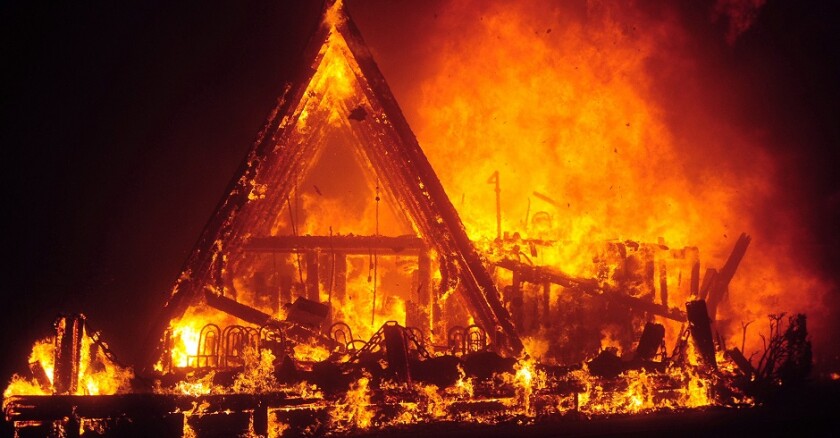Citing wildfire liabilities upwards of $30 billion, Pacific Gas and Electric Co., the state’s largest electric utility, recently filed for bankruptcy. Headlines hail this the first of many “climate change bankruptcies.” But climate change is only one factor. These fires would not be so big if we did not send power through thousands of miles of tinderbox forest at high-risk times. Liabilities would not be so large if fewer people lived in high fire-risk areas.
Californians are going to pay, one way or another, to adapt to mounting fire risks. How we adapt will depend in part on how the bill is split, which makes this a first-order policy problem.
Let’s start with how the risks are shared. The majority of firefighting costs and property losses in recent wildfire seasons have been incurred in the “wildland-urban interface” (WUI), where houses are located in or near wildland vegetation. The WUI occupies less than 10 percent of the land area of the United States, but accounts for 43 percent of all new houses built in 1990-2010.
This WUI population is expected to keep growing. Lots of people, myself included, dream of someday moving to a place where wilderness is your backyard. When contemplating this move, we should be considering not only the sublime benefits of being close to wilderness, but also the risk that the wilderness will catch on fire. Under current law, however, California property owners (and their insurance companies) are entitled to compensation for any property damage if utility electrical equipment caused the fire — even if the utility was operating in full compliance with regulations.
I’m not suggesting that all people living in high-risk areas should bear all fire-related property damages. It’s important that utilities bear the costs if they are found negligent. And there are obvious fairness concerns with hitting current WUI/wilderness residents with significant increases in insurance costs, especially given that we all have played a role in turning up the global temperature. But shielding wilderness dwellers from mounting fire risks will result in too many people choosing to live in high-risk areas. And that’s an important reason to reform how wildfire risk-sharing works in California.
In addition to rethinking risk-sharing, we also must up our prevention game. There are many mitigating steps that power companies are already pursuing, including vegetation clearing and undergrounding power lines. Perhaps the most controversial strategy in PG&E’s recently released fire safety plan: a significant increase in the scope of planned power outages when fire risk gets high.
Highly charged debates about when and how to de-energize are complicated by a tension between the obligation to provide a reliable power supply to all customers and the obligation to protect against fire risk. If you live in a wilderness area, you are understandably concerned about having your power shut off as a fire moves in.
But what if a more aggressive de-energizing strategy were coupled with investments in battery storage that could help high-risk communities maintain supply during planned power outages? What if remote communities could self-power their emergency needs from a locally managed extra-safe private network? California has already mandated significant increases in self-generation (such as solar systems) and battery storage. If these investments were targeted at high fire-risk areas, this could help clear a path for more aggressive de-energizing strategies.
But if all liability for fire damage from electrical equipment lies with utilities, and if prevention efforts focus primarily on fireproofing the electricity grid (instead of changing how and when power flows across it), the costs of prevention and the subsequent wildfire damage will be higher than they need to be. To bring these costs down, we need to rethink how costs and liabilities are assigned. And think creatively about how to meet electricity demand in high-risk areas.
Politically, preventing wildfires in California may prove to be more challenging than containing them once they start. But given the devastatingly high stakes, this is political capital worth spending.
–––
(Meredith Fowlie is a University of California, Berkeley economist and research associate at the Haas Energy Institute.)
———
©2019 The Mercury News (San Jose, Calif.)
Visit The Mercury News (San Jose, Calif.) at www.mercurynews.com







